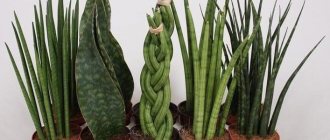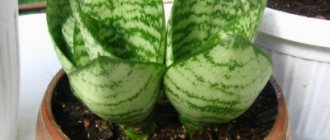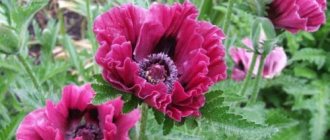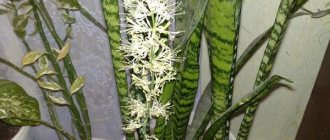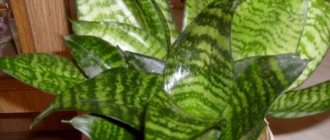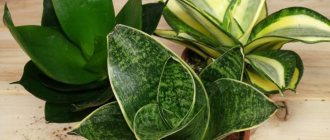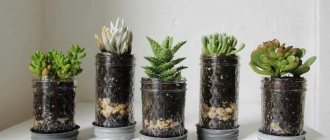Author: Elena N. https://floristics.info/ru/index.php?option=com_contact&view=contact&id=19 Category: Houseplants Published: February 21, 2019Last edits: January 11, 2021
- Rhizome division
- Sansevieria grandis
Not many gardeners know that Sansevieria loves to spend its summer holidays outdoors. But in vain! After all, for such a “vacation”, a plant with a bunch of the most formidable names will almost certainly thank you with a modest, but so vanilla-fragrant flowering! How to arrange everything? With the onset of stable spring warmth, a pot of sansevieria can be placed on a balcony or veranda, but it is even better to transplant the “tongue of Satan” into open ground. The main thing is not to forget to take the rested and strengthened sansevieria home in September. Interesting fact: at home, Sansevieria most often blooms when... its pot becomes too small for it! After enjoying the long-awaited flowering, do not forget to replant the flower. How to do this correctly, as well as about the nuances and possible problems in growing sansevieria, read in our article.
Planting and caring for sansevieria
- Flowering: decorative deciduous plant.
- Lighting: partial shade, bright diffused light.
- Temperature: normal for residential premises. In winter, not lower than 16˚C.
- Watering: regular, moderate, more frequent in summer than in winter.
- Humidity: normal for residential premises.
- Feeding: during the active growing season, once a month with a fertilizer solution for cacti or decorative foliage plants.
- Rest period: not clearly expressed.
- Repotting: when the pot becomes too small for the plant.
- Reproduction: vegetative (by rhizome division or leaf cuttings).
- Pests: mealybugs, thrips, spider mites.
- Diseases: anthracnose, root rot.
Read more about growing Sansevieria below.
Sansevieria , or sansevieria , or sansevieria , is a genus of the Asparagus family (in some catalogs - Agaveceae), which includes more than 60 species of evergreen perennial stemless plants from the rocky, dry regions of the tropics and subtropics of Africa, Madagascar, South Florida, Indonesia and India. This unpretentious and therefore popular indoor plant in different countries has received the nicknames “pike tail”, “snake skin”, “mother-in-law’s tongue”. Its value is that it is indestructible: you can forget about it for a week or two, and it will not die or dry out. In addition, the Sansevieria plant is happily used by designers to create flower arrangements and decorate interiors.
Wonderful home decoration - “Pike Tail”
Many gardeners are happy to grow it indoors, since Pike Tail or, as they are also called, Snake Skin, Indian Sword, Tiger Lily, Cat's Tail, is a completely unpretentious plant. It can easily withstand dry days when people forgot to water it or placed it in partial shade. At the same time, its decorativeness is not lost at all.
Brief botanical description
- The plant belongs to the Asparagus family and is a perennial herbaceous flower.
- Under natural conditions, the plant can be found in southern countries with tropical and subtropical climates: Africa, Indonesia, India and even Madagascar. The leopard lily has a unique structure: unlike most plants, it has no stems, but only rosettes of leaves.
- The flower is considered decorative - leafy, but very rarely it blooms with inconspicuous white flowers, which do not stand out in anything particularly remarkable: small in size, collected in a spike-shaped inflorescence, located on an elongated peduncle, with a pleasant weak aroma. The color is whitish-green, the opening of the buds appears only in the evening hours.
- Currently, more than 50 species and many varieties are known.
- Parts of the plant and the juice have beneficial properties: they treat cystitis and inflammation of the ovaries, instill the juice in the ears and treat otitis, and heal wounds. You can also place the Pike Tail not far from the computer, since the flower tissues absorb radicals and harmful radiation.
Features of cultivation
Each plant has its own whims, and if you are going to grow this or that flower in the house, you need to familiarize yourself with its agricultural technology and decide whether it is suitable for you or not. Indoor Sansevieria is good because it requires very little attention, but at the same time it looks wonderful.
So, what is interesting about Sansevieria:
- It is enough to fertilize it once a year, but if you do it more often, it will certainly accept it with pleasure;
- the best place for sansevieria is a windowsill, since it needs as much natural light as possible, and it doesn’t really matter whether it’s warm or cold on the windowsill;
- and yet direct sunlight can cause burns to the plant, so place the sansevieria on the windowsill of the window into which the sun peeks in in the late afternoon;
- The worst thing for sansevieria is waterlogging of the soil, which causes it to die.
Transfer
Young “pike tails” are replanted annually in the spring, in March-April . Mature specimens need more rare spring “relocations”, once every two to three years .
Despite this, the next container for planting is chosen only slightly larger than the previous one - the roots of the “pike tail” grow slowly and pathogenic processes can occur in the soil “undeveloped” by the plant.
As a rule, “mother-in-law’s tongues”, under more or less suitable conditions, grow well with rhizomes with new, young shoots.
Such rhizomes are planted , separating the side shoots. The shoot that has at least one growth bud can become an independent plant in a separate container.
In this case, each container is provided with a sufficient drainage layer and suitable soil.
An extremely hardy resident of our apartments and offices, Sansevieria - “pike tail” and “mother-in-law’s tongue” - has every right not to survive, but to live fully; She readily responds to even minimal care .
Correctly and timely transplanted sansevieria develops well, produces abundant shoots, blooms - and, according to the NASA list, actively absorbs such toxic atmospheric impurities as nitric oxide and formaldehyde .
Caring for Sansevieria at home
Rules of care
Any temperature is suitable for sansevieria, air humidity will also not particularly affect the growth and appearance of the plant, but still, if you want to see sansevieria in its best form, try to ensure that in winter the room temperature does not fall below 16 ºC, and the leaves of sansevieria It's a good idea to wash it from time to time.
- Begonia: growing at home
Caring for sansevieria means, first of all, proper watering, but by experimenting with watering, you risk destroying the flower. Therefore, it is best to take advantage of such an achievement of civilization as a humidity indicator, which you can buy at a flower shop and which will remind you that it is time to water the flower. It is better to use rainwater, distilled water, or at least at room temperature for irrigation. In winter, the colder the room, the less often the sansevieria needs to be watered. Wash off the dust from the plant with a damp sponge.
Transfer
You will not have to replant sansevieria often - young plants need replanting once every two years, mature ones - once every three. You can read about how to replant sansevieria on many websites, but not everywhere there is information about what soil mixture sansevieria prefers: it is better to buy soil for the plant at a flower shop, because soil from the garden will not suit it.
The composition of the soil should be approximately this: one part each of leaf soil and sand and two parts of turf soil. Store-bought soil also contains perlite or fine gravel.
Sansevieria is replanted only when the roots of the plant appear from the drain hole of the pot. Choose a thick-walled pot, preferably clay, so that the powerful root system of the plant does not tear it apart, and long, heavy leaves do not overturn the pot. The shape of the pot, due to the peculiarities of the development of the root system, should be wide rather than deep. And remember: the most important thing is a good drainage layer.
Fertilizer
In the spring and summer, you can feed sansevieria monthly with liquid mineral fertilizers for indoor crops or cacti. Make sure that excess nitrogen does not damage the plant, and in general, try to keep the consistency two times weaker than recommended.
For species with colored stripes, the dose of fertilizing must be reduced by three times, otherwise the leaves may lose their decorative effect and become uniformly green.
- Savoy cabbage: growing in the garden, varieties
Temperature
Sansevieria is absolutely indifferent to temperature changes. In summer, it feels great at temperatures from 18 to 25°C, and in winter from 14 to 16°C, but not lower than 10°. Low temperatures may cause growth to slow down or stop altogether.
You may be interested in:
Growing heuchera from seeds at home Heuchera is one of the representatives of saxifrage. The plant is perennial. This herbaceous plant comes from Northern...Read more...
Sansevieria propagation
Rhizome division
Sansevieria is propagated by dividing the rhizome, lateral shoots and dividing the leaf. The most convenient way to divide the rhizome of a plant is during spring replanting: use a sharp knife to cut the rhizome so that a growing point remains on each part. Place the divided sansevieria in different pots and place them in a warm place. Water sparingly. This method is suitable for both monochromatic and variegated types of sansevieria.
Reproduction by leaf division
Also a simple procedure. The old leaf is cut into pieces 4-5 cm long, dried a little in the air, then the lower end is immersed in sand at an angle of 45º, covered with a jar or cut-off plastic bottle and, with moderate bottom watering (water is poured into the tray of the pot), rooted.
After 30-40 days, as soon as the leaf takes root and produces buds from which young leaves appear, the plant is transplanted into a pot with soil. This method is suitable only for monochromatic species of sansevieria: even if you root a striped leaf, the baby will still grow green.
Properties of Sansevieria
Sansevieria contains many biologically active substances, but the most popular of them are saponins, which, when used correctly, bring significant benefits. Traditional medicine uses saponins to produce choleretic, anti-inflammatory, laxative and expectorant drugs. Traditional medicine treats cystitis, inflammation of the oral cavity, otitis, cuts and other skin injuries with sansevieria.
The foaming properties of saponins are used in the cosmetics industry in the production of liquid soap and shampoos. It is not recommended to use the plant for medicinal purposes by pregnant women, since the substances it contains have an abortifacient effect.
Kinds
Sansevieria has a creeping rhizome with basal leaves, powerful and hard, reaching a height of 1 meter or more. The leaves come in varying shades of green and brown, and some have stripes or spots. The flowering of Sansevieria is not very attractive: white and green flowers, collected in cylindrical inflorescences, opening towards sunset, exude a subtle vanilla aroma. The fruit is a berry with several seeds, but in indoor conditions Sansevieria rarely bears fruit. The most famous types of Sansevieria:
Sansevieria grandis
Perennial, rosette of 2-4 succulent light green leaves 30-60 cm long and up to 15 cm wide. There are dark transverse stripes along the leaves, and along the edge there is a reddish border;
- Home care for Ficus Benjamin
In the photo: Sansevieria grandis
Sansevieria hyacinthoides
The plant is up to half a meter high, the leaves grow in bunches of 2-4 pieces, length from 14 cm to 45 cm, width up to 7 cm. The color of the leaves is dark green with light green W-shaped strokes, the edges of the leaves are reddish or whitish;
In the photo: Sansevieria hyacinthoides
Sansevieria dooneri
An indistinct leaf succulent that forms rosettes containing up to 20 flat, erect leaves up to 40 cm long and up to 3 cm wide. The leaf color is green with a dark green pattern;
In the photo: Sansevieria dooneri
Sansevieria graceful (Sansevieria gracilis)
Or graceful Sansevieria - a perennial succulent: the leaves cover the base of the stem 5-6 cm high. The leaves are leathery, oval, long-pointed, gray-green in color with gray-beige transverse streaks;
In the photo: Sansevieria graceful or graceful (Sansevieria gracilis)
Sansevieria kirkii
This plant has a short rhizome and rosettes with a small number of green leaves with whitish spots with a red-brown edge. There are varieties with brown or red-brown leaves;
In the photo: Sansevieria kirkii
Sansevieria liberica
An indistinct leaf succulent with unfolded rosettes of 6 flat leaves parallel to the ground. The length of the leaves sometimes reaches 100 cm in length and 8 cm in width, but this is only in very large specimens. The color of the leaves is dark green with blurry light green streaks and streaks, along the edge of the leaf there is a thin reddish-white or brown stripe.
In the photo: Sansevieria liberica
Sansevieria trifasciata
But in indoor floriculture, the most common species is Sansevieria three-stripe - a tall plant with sword-bearing leaves of green or green color with a yellow border. Rosette Sansevieria trifasciata Hahnii with green or striped leaves is also a favorite among lovers. They are very beautiful and unpretentious, and besides, you already know how to care for sansevieria.
In the photo: Sansevieria trifasciata
What to do if it doesn’t take root?
Sansevieria does not require special care, it is hardy, so it is almost always possible to get “offspring” without much difficulty. The main reason that the plant does not take root is excessive watering, which can result in rotting of the tip of the cutting after planting. The solution is simple:
- the petiole is taken out of the ground;
- the rotten tip is cut off;
- dried in the open air and takes root again.
Stems may dry out and die. Most likely, the root system was severely damaged during division. In this case, dead stems are removed. The plant as a whole needs to be constantly monitored. Another sansevieria transplant may be required.
“Pike tail” is a bright element of decor, a good “healer” of a person and the atmosphere. The desire to have this plant in your home is understandable. By taking a few simple steps, you can acquire more than one copy of this miracle flower.
Difficulties may arise when caring for Sansevieria, so we recommend reading the article about diseases and pests of the flower, and also looking at a photo of the affected plant.
